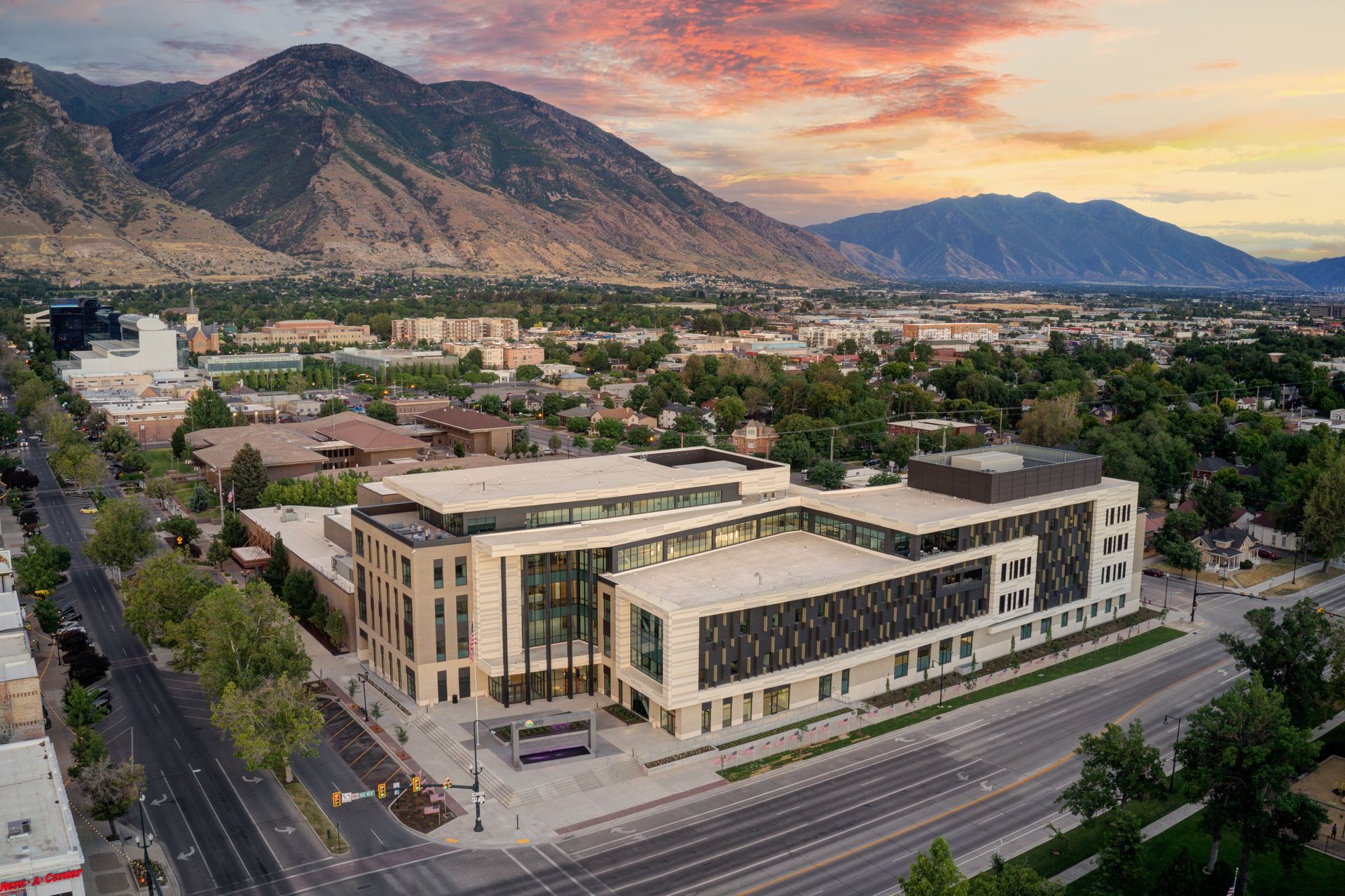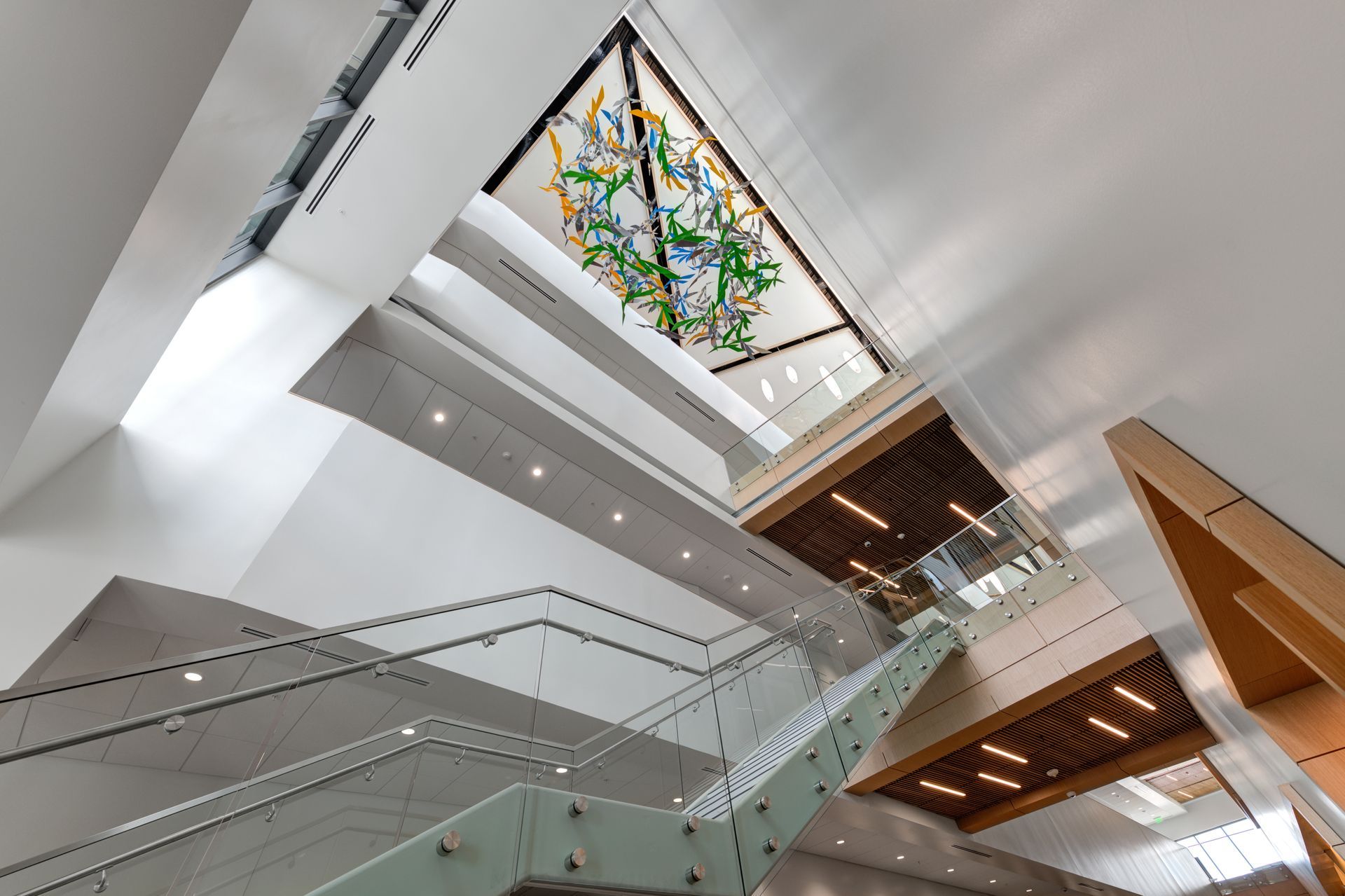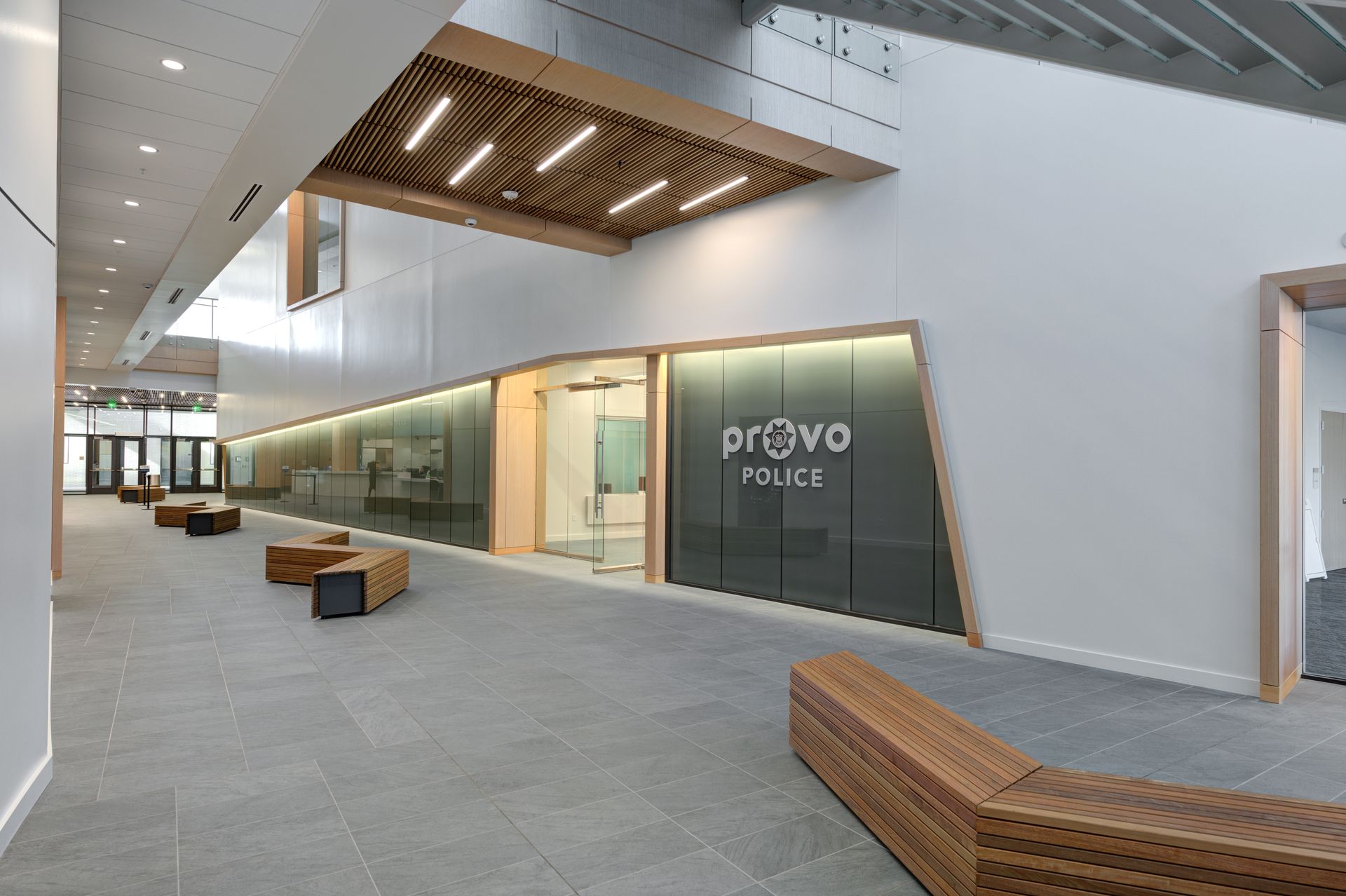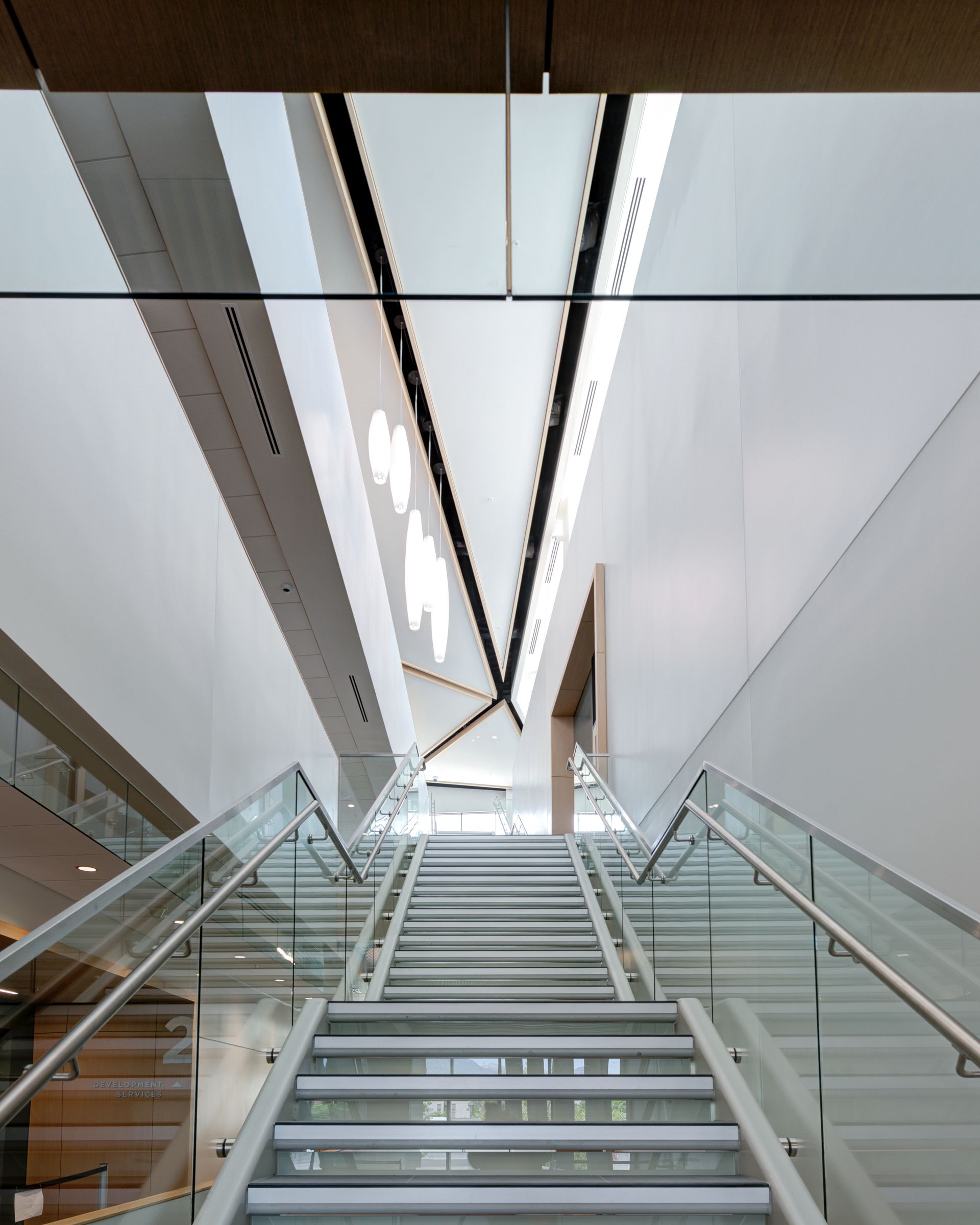The dynamic, new, $69-million Provo City Hall and Public Safety Building is a boon to the citizens of Utah’s fourth-largest city. By Brad Fullmer

Complex Building with Multiple Tenants Challenges Design Team
The combination of end users makes the Provo City Hall and Public Safety Building one of the more remarkable projects constructed in the city’s recent history, particularly considering the functionality needed for the different occupants.
Tippets, Principal-in-Charge for VCBO, admitted that his team—which included Casey Skinner (Project Manager) and Nathan Leavitt (Project Architect)—really had to “put on our thinking caps to solve a lot of problems” with how to accommodate multiple needs in one building.
“The combination of public safety combined with city hall functions makes it very unique—more so than you might think,” said Tippets. “The separation of all the security was quite a challenge. We came up with a good solution with public safety on one side and city on the other side.”
A dynamic four-story lobby space designed around a “slot canyon” concept turned out to be an incredible visual highlight that worked well within the space constraints, Tippets added. The design team spent a great deal of time during planning phases interviewing various end users to ensure staff and citizens would get everything they needed.
“We’ve done several municipal-type projects, and this one was unique,” said Tippets. “We had to go in quite deep on the public safety side and understand all their needs and even try to see beyond what their needs were. They lived in such an archaic facility for so long. We did some research on some other facilities and reached out for input.”
The client requested that police/public safety/911 emergency operations spaces be designed to meet the national standards of the Commission on Accreditation for Law Enforcement Agencies —both from a functional and physical facility standpoint.
Another highlight is that the building was designed to meet stringent Net Zero sustainability standards. The all-electric building required a complex energy model along with specialized HVAC and cooling systems.
The electrical system, designed by Salt Lake-based Spectrum Engineers, required careful coordination with Provo City Power for redundant utility service to the building. A powerful 2.5-MW diesel generator provides backup for critical functions, ensuring continued operation during power outages or other catastrophic events. The data center was engineered for 99.99% reliability and uptime and features digitally controlled LED luminaires with automatic occupancy and daylighting sensors. Other technological highlights include state-of-the-art audio/visual systems, video surveillance, access control, intrusion detection, and structured cabling for all data networks.
Structurally, the building is designed to withstand a major seismic event with a structural steel and buckling restrained brace system with concrete on metal decking. Exterior finishes of steel, concrete, brick, GFRC, EIFS, and an aluminum storefront offer a strong aesthetic appeal.
Construction Team Measures Up
For Brian McBeth, Layton’s Construction Manager, this project brought back fond memories of his time studying construction management at Brigham Young University. A newlywed at the time, he and his wife lived for a year in an apartment a stone’s throw away from the project site, which used to be home to a Firestone tire shop and Rocky Mountain Drive-In.
“My wife and I would go there for shakes and dinner,” he recalled. “We had our first son in Provo and used to take him to get ice cream and go play in Pioneer Park [across the street from the new complex].”
McBeth said the building, which broke ground in April 2020 (coinciding with the pandemic), proved to be a more challenging project due to the uniqueness of building a multi-functional space coupled with the many negative factors mentioned by Henderson.
“Building-wise, it was unique because it was the marrying of separate offices and buildings […] and just trying to bring everybody into one building. Anytime you bring police into a building, it makes the building type different,” McBeth said, citing ballistics glass and drywall needs, and other measures for city council chambers.
During initial excavation, crews encountered underground oil tanks that required state remediation, an old swimming pool, and other old structural elements. McBeth said it was a “very interesting site” with flowing water at about 12 feet underground. An elaborate dewatering process with seven pumps was put in place for crews to build footings and do foundation work.
Overall, he said, the entire construction team performed admirably over the 26-month schedule, despite the project starting at the tail end of tariffs, the early days of Covid, supply chain and price escalation issues, etc.
“You think of some of the worst building times we’ve been through, and it all hit on this one project,” said McBeth. “We got the ‘best of everything’ on this project and still finished on time and under budget.”
Provo City Hall and Public Safety Building
Cost: $69 million ($57 million construction cost)
Delivery Method: CM/GC
Square Feet: 205,000
Levels/Stories: Five levels (with basement)
Owner: Provo City
Owner’s Rep: Scott Henderson; Dick Blackham
Design Team
Architect: VCBO Architecture
Civil: Great Basin Engineering
Electrical: Spectrum Engineers
Mechanical: Heath Engineering
Structural: Reaveley Engineers
Geotech: GSH Geotechnical
Landscape: Arcsitio Design
Construction Team
General Contractor: Layton Construction
Concrete: Layton Construction
Plumbing: KHI Mechanical
HVAC: KHI Mechanical
Electrical: Wilkinson Electric
Masonry: Troy Hales Masonry
Drywall: Muddy Boys, Inc.
Acoustics: K&L Acoustic & Drywall, Inc.
Painting: Grow Painting
Tile/Stone: Millcreek Tile & Stone
Carpentry: Associated Fixture Manufacturing
Flooring: Design Team
Roofing: Flynn/Noorda
Glass/Curtain Wall: Linford Contract Glazing
Waterproofing: Hooley Caulking, Inc.
Steel Fabrication: Schuff Steel
Steel Erection: J&M Steel Solutions
Excavation: Siri Contracting
Demolition: Siri Contracting
Landscaping: Stratton & Bratt Landscapes
Fun Facts:
1,400 tons of steel on the project. 1,400 tons x 2,000 lbs. = 2.8 million pounds of steel.
- miles of plumbing piping
4.1 miles of HVAC duct/159,00 lbs. of duct (weight of 130 steel frame cars)
262,000 LF (about 50 miles) of conduit. If you add MC cable it increases to 84 miles.
9,300 cubic yards of concrete = 4-ft. wide sidewalk 35 miles long.
The project includes space for: police administration; fire administration; secure parking; holding cells; dog kennels; emergency operations center; dispatch/911 call center; crime lab; armory; SWAT; training room; vehicle evidence bays; evidence storage; physical fitness training/gym; electronic crimes division; community/press room.
































